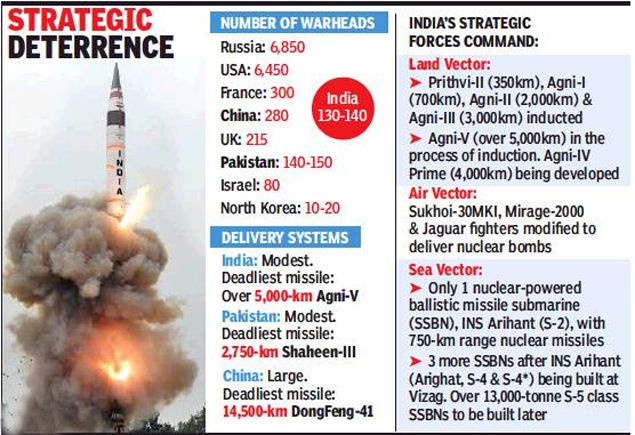International Relations
Credibility of Nuclear Deterrence
- 11 Aug 2020
- 8 min read
This article is based on Bringing nuclear risks back into popular imagination which was published in The Hindu on 10/08/2020. This article deals with the pros & cons of nuclear deterrence and new challenges to the doctrine.
6th August 2020 marked the 75 year of humanitarian crisis that was caused by the dropping of a nuclear bomb on Hiroshima and Nagasaki in Japan by the United States of America.
It has been 75 years since then, the world hasn’t seen the use of nuclear bombs. Many security experts all around the globe attribute this stability and world peace, to the Nuclear Deterrence Doctrine. Moreover, after the end of the Cold War the possibility of a nuclear war has been further diminished.
However, technological and other geopolitical development, in present times, has raised concerns about the efficacy of Nuclear Deterrence doctrine.
Therefore, the need of the hour is the revival of public debate on the humanitarian cost of Nuclear war or accident and elimination for nuclear arsenal.
What is Nuclear Deterrence?
- Nuclear Deterrence is a military doctrine according to which the possibility that a country will use the nuclear weapons it possesses in retaliation will deter an enemy from attacking.
- This doctrine is based on the underlying philosophy that Nuclear weapons are so destructive that no country would use them, because such use would cause massive humanitarian crisis and no political leader would be willing to risk the possible death of millions of their citizens.
Advantages of Nuclear Deterrence
- Nuclear Weapons, As a deterrent to Global Conflict: The threat of being overpowered or having mutually-assured destruction is enough to prevent the world’s superpowers from escalating a conflict to the point that a military confrontation becomes necessary.
- Deterrence enthusiasts claim that nuclear weapons do not just protect countries against use of nuclear weapons by others, but even prevent war and promote stability.
- Enhances Bargaining Power of a Country: Nuclear weapons gives a geo-strategic advantage to countries.
- For example North Korea has independently developed this technology, giving it a seat at the negotiation table with the USA.
- Increased Scope of Weapons Maneuverability: Nuclear weapons can be launched from Land, Water and Air.
- This provides much flexibility to Nuclear weapons as their conventional counterparts. This versatility is a definite advantage when considering the scope of deterrence doctrine.
Disadvantages of Nuclear Deterrence
- Doesn’t Stall Warfare at Small Scale: Nuclear weapons have not been shown to prevent small scale/guerrilla warfare. As there is always a possibility of escalation of conflict, the chance of Nuclear Warfare can not be eliminated.
- Unequal Advantage: With the unequal distribution of nuclear capabilities in today's world, certain nations are at an immediate advantage over other countries.
- Since 1945, the United States, the Soviet Union/Russia, the United Kingdom, France, China, Israel, India, Pakistan, and North Korea have armed themselves with nuclear weapons that have much more destructive power in comparison to those that destroyed Hiroshima and Nagasaki.
- Not Applicable Against Non-State Actors: Nuclear deterrence does not protect against nuclear terrorists, who are not tied down by a specific nation.
- No Guarantee of World Peace: There is no assurance of peace even both the conflicting countries may possess nuclear weapons.
- The most famous of these cases is the 1962 Cuban Missile Crisis.
New Challenges To Nuclear Deterrence Doctrine
- Emergence of the New Cold War: As the world has entered into the phase of a new Cold War between US and China, the chances of nuclear conflict has again resurfaced.
- Further, as nuclear capabilities grow and inter-state trust diminishes, chances of stumbling into nuclear war are high.
- Among the risks of nuclear use, there is a likelihood is that of inadvertent escalation due to miscalculation or misperceptions.
- Emergence of Rogue States: Rogue nation or state regarded as breaking international law and posing a threat to the security of other nations.
- Due to possession of Nuclear weapons with North Korea, many countries perceive it as a rogue state.
- Also, countries with nuclear weapons may deploy them through proxies or non-state actors.
- Chance of Limited Nuclear War: Limited nuclear war is defined as war in which each side exercises restraint in the use of nuclear weapons, employing only a limited number of weapons on selected targets.
- Selected targets could include enemy forces, command and control centers or particular sites of strategic importance.
- Technological Advancement: Industrial revolution 4.0 has blurred the lines between conventional and nuclear delivery. For example:
- Advancing capabilities of cyberattacks on nuclear command and control.
- Induction of hypersonic missiles capable of high speed and manoeuvrability, has made it impossible to intercept nuclear weapons once they are launched.
- Incorporation of artificial intelligence in nuclear decision making are new developments that threaten to create unknown risks.
Conclusion
Hiroshima and Nagasaki attacks have shown the scale of massive human tragedy and long-term repercussions for food & water availability, agricultural output, climate change, migration, etc.
In order to get nations to understand this, there is a need to compel nations to rationalise their weapon requirements; force them to find ways of reducing nuclear risks; and gradually pave the path towards elimination of nuclear weapons. This could be most effectively done through use of Creative media.
|
Drishti Mains Question Amid technological and other geopolitical development, discuss the viability of nuclear deterrence as an instrument of world peace. |
This editorial is based on “Balancing priorities: On development and environment” published in The Hindu on August 10th, 2020. Watch this on our Youtube channel now.





